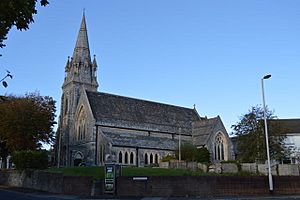St Jude's Church, Plymouth facts for kids
Quick facts for kids St Jude's Church |
|
|---|---|

St Jude's Church
|
|
| Religion | |
| Affiliation | Church of England |
| Ecclesiastical or organizational status | Active |
| Year consecrated | 1876 |
| Location | |
| Location | Plymouth, Devon, England |
| Architecture | |
| Architect(s) | James Hine |
| Architectural type | Church |
St Jude's Church is a special building in Plymouth, Devon, England. It is a Church of England church. This means it belongs to the main Christian church in England.
The church was designed by a local architect named James Hine. It was built a long time ago, between 1875 and 1876.
Contents
History of St Jude's Church
Building the Church
Work on St Jude's Church began in 1875. A special stone, called a memorial stone, was laid on October 26, 1875. This marked the start of the building process.
The church was officially opened on November 27, 1876. This ceremony is called a "consecration." The Bishop of Exeter, Frederick Temple, led the consecration.
St Jude's was one of several churches built by the Three Towns Church Extension Society. This group helped build new churches in the area.
Later Additions
After the main church was finished, more parts were added. A tall tower and a spire were built between 1881 and 1882. A spire is a pointed structure on top of a church tower.
Later, a church room was added in 1887–88. This room provides extra space for church activities.
Protecting the Building
St Jude's Church is a very old and important building. Because of its history and design, it has been a Grade II listed building since 1975.
Being "Grade II listed" means the building is protected. It is considered historically or architecturally important. This helps make sure it is kept safe for future generations.
Design and Materials
Historic England describes St Jude's Church as having an early and mid Gothic style. This style often includes pointed arches and large windows.
The church was built using strong materials. The main part of the church is made from Plymouth limestone. Special details, like window frames, use Portland stone and Bath stone.
When it was first finished, St Jude's Church could hold about 650 people.

